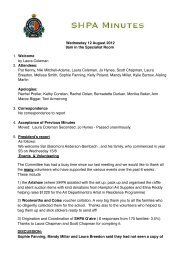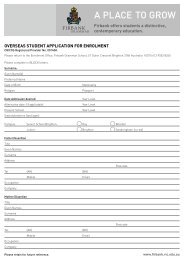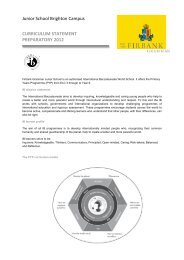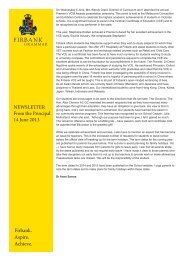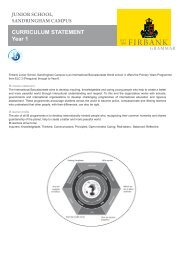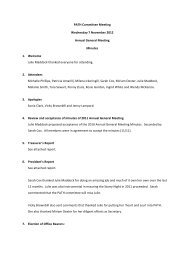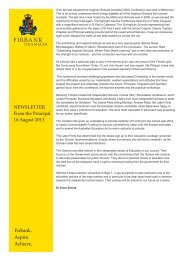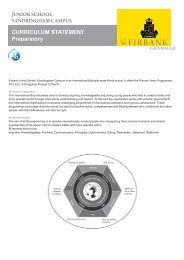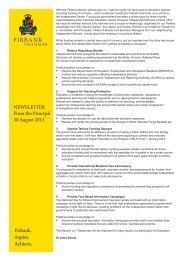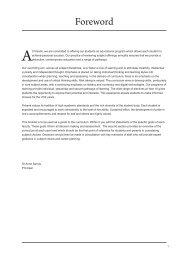CURRICULUM STATEMENT Year 2 - Firbank Grammar School
CURRICULUM STATEMENT Year 2 - Firbank Grammar School
CURRICULUM STATEMENT Year 2 - Firbank Grammar School
You also want an ePaper? Increase the reach of your titles
YUMPU automatically turns print PDFs into web optimized ePapers that Google loves.
JUNIOR SCHOOL,<br />
BRIGHTON CAMPUS<br />
<strong>CURRICULUM</strong> <strong>STATEMENT</strong><br />
<strong>Year</strong> 2<br />
EST<br />
1909<br />
FIRBANK<br />
GRAMMAR<br />
<strong>Firbank</strong> Junior <strong>School</strong>, Brighton Campus, is an authorised International Baccalaureate World <strong>School</strong>. It offers the Primary <strong>Year</strong>s<br />
Programme from ELC 3 through to <strong>Year</strong> 6.<br />
IB mission statement<br />
The International Baccalaureate aims to develop inquiring, knowledgeable and caring young people who help to create a better and more<br />
peaceful world through intercultural understanding and respect. To this end the IB works with schools, governments and international<br />
organizations to develop challenging programmes of international education and rigorous assessment. These programmes encourage<br />
students across the world to become active, compassionate and lifelong learners who understand that other people, with their differences,<br />
can also be right.<br />
IB learner profile<br />
The aim of all IB programmes is to develop internationally minded people who, recognizing their common humanity and shared<br />
guardianship of the planet, help to create a better and more peaceful world.<br />
IB learners strive to be:<br />
Inquirers; Knowledgeable; Thinkers; Communicators; Principled; Open-minded; Caring; Risk-takers; Balanced; and Reflective.<br />
The PYP curriculum model
Programme of Inquiry (POI)<br />
As far as possible all subject areas relate to the programme of inquiry. Over the course of a year each grade level completes six units<br />
of inquiry, one from each transdisciplinary theme.<br />
The <strong>Year</strong> 2 units of inquiry (UOI) are:<br />
Term 1 Term 1 & 2<br />
Transdisciplinary Theme: Who we are Transdisciplinary Theme: Where we are in place and<br />
time<br />
Central Idea:<br />
Choices we make have an<br />
impact on our relationships.<br />
Central Idea:<br />
Our lives are similar and<br />
different to those of other<br />
generations.<br />
Lines of inquiry:<br />
• Our relationships<br />
• How positive choices can<br />
nurture relationships<br />
• Rights and responsibilities<br />
Lines of inquiry:<br />
• Generations<br />
• Why and how things change<br />
over time<br />
• How we know about the<br />
past, present and future<br />
Concepts: Causation, Responsibility Concepts: Reflection, Change<br />
Term 2 Term 3<br />
Transdisciplinary Theme: How the world works Transdisciplinary Theme: How we organise ourselves<br />
Central Idea:<br />
We use our senses<br />
to interact with our<br />
environment.<br />
Central Idea:<br />
People choose different<br />
systems to get from one place<br />
to another.<br />
Lines of inquiry:<br />
• Our senses and how we<br />
use them<br />
• Why our senses are<br />
important<br />
• What to do with limited or<br />
no sense<br />
• Technology designed to<br />
enhance the senses<br />
Lines of inquiry:<br />
• Types of transport<br />
• Different transport systems<br />
Concepts: Function, Causation, Concepts: Form, Function, Connection<br />
Term 3 and 4 Term 4<br />
Transdisciplinary Theme: Sharing the planet Transdisciplinary Theme: How we express ourselves<br />
Central Idea:<br />
An ecosystem is a<br />
constantly changing<br />
community of living things<br />
interacting with another.<br />
Central Idea:<br />
Cultural beliefs and values are<br />
reflected through traditions.<br />
Lines of inquiry:<br />
• The similarities and<br />
differences between living<br />
and non-living things<br />
• Characteristics of local<br />
ecosystems<br />
• Connections within<br />
ecosystems<br />
Lines of inquiry:<br />
• How artefacts symbolise<br />
beliefs and values<br />
• How traditions reflect beliefs<br />
Concepts: Change, Connection Concepts: Perspective, Reflection
Language<br />
Reading<br />
In <strong>Year</strong> 2, the students are encouraged to read independently and respond to imaginative and informative texts. Students are exposed<br />
to unfamiliar vocabulary and will use strategies for working out the meaning of unfamiliar words in context. The students use text and<br />
diagrams to locate and interpret both literal and inferred meaning. Students begin to make more personal connections with the text and<br />
are encouraged to relate text with real life experiences. As students become independent readers, they self correct and use punctuation<br />
cues to gain a deeper understanding of the text.<br />
Writing<br />
Students in <strong>Year</strong> 2 are provided with authentic contexts in which to write for a range of purposes. Students select content, form and<br />
vocabulary depending on the purpose and audience for their writing. They use appropriate structures to organise the subject matter and<br />
the grammatical features of these structures are reinforced. They spell frequently used words accurately and make use of known spelling<br />
patterns to make attempts at spelling unfamiliar words.<br />
Speaking and Listening<br />
In <strong>Year</strong> 2 students are provided with authentic contexts in which to produce spoken texts. To add emphasis when communicating, students<br />
have the opportunity to demonstrate they are able to speak clearly by varying their volume and modifying their tone and pace. They make<br />
relevant comments and ask clarifying questions to facilitate communication. After listening to short live or recorded presentations, they<br />
recall some of the main ideas and information presented. They listen to others and respond appropriately to what has been said.<br />
Mathematics<br />
Number<br />
Students model place value of whole numbers from 0 to 1000. They order numbers and count to 1000 by 1s, 10s and 100s and skip count<br />
by 2s, 4s and 5s to 100, starting from any whole number. Students form patterns and sets of numbers based on simple criteria such as<br />
odd and even numbers. They order money amounts in dollars and cents and carry out simple money calculations. Students describe<br />
simple fractions such as one half, one third and one quarter in terms or equal sized parts of a whole object, such as a quarter of a whole<br />
object and subsets (e.g. half of a set of 20 items). Students add and subtract one and two-digit numbers. They also use strategies to<br />
assist in mentally solving addition and subtraction calculations. Students describe and calculate simple multiplication as repeated addition<br />
and division as sharing.<br />
Measurement, Chance and Data<br />
Students estimate, measure, compare and record length, area, volume, capacity and mass using some formal units. They recognise the<br />
need for formal units of length and use the metre and centimetre to measure length and distance. Students use a calendar to identify the<br />
date and name and order the months and the seasons of the year. They use informal and formal units to compare and order the duration<br />
of events and tell the time on the half-hour. They read and record time in hours and minutes in digital and analogue notation and make<br />
comparisons between time units. Students gather, organise, display and interpret data using column and picture graphs. Students order<br />
familiar events in terms of probability between impossible and certain, to predict chance.<br />
Space<br />
Students identify, describe, sort and model particular 3D objects and 2D shapes. Students recognise and describe symmetry, asymmetry<br />
and congruence in these shapes and objects. The students represent and describe the position of objects and recognise whether a single<br />
transformation produces a congruent or similar shape. Students specify location as a relative position, including left and right and interpret<br />
simple networks, diagrams and maps involving a small number of pints, objects or locations.<br />
Working Mathematically<br />
Students ask questions and use appropriate mental or written strategies, and technology, to solve problems. They use appropriate<br />
terminology to describe and link mathematical ideas, check statements for accuracy and explain reasoning.
Art<br />
In Art, <strong>Year</strong> 2 students learn skills, techniques and processes with two and three dimensional art media. The new skills are learnt and<br />
added, in a sequential way, to previous learning. Their understanding and use of the PYP learner profile and attitudes and the values<br />
contained in them, is applied in the art situation. Concepts which are a part of the classroom program of inquiry are linked where possible,<br />
to Art. In Term 1, the class unit of inquiry into homes, their design and building materials, will initiate art activities. Concepts of Form and<br />
Texture will be a particular focus. Reference will be made to the work of artists, past and present where relevant. Through the year in Art,<br />
there is an emphasis on enjoyment and confidence. The students learn skills and techniques which can be applied in diverse ways. In<br />
Art, individuality of expression is valued and celebrated in each child.<br />
Music<br />
All classroom Music lessons are voice-based. In singing before they begin to read, students internalise music and can begin to work with<br />
it meaningfully very quickly. Students are led to recognise and name musical elements in a structured and sequential way, in accordance<br />
with known child developmental stages. Early lessons begin with the building of a repertoire of songs, usually accompanied by a game,<br />
meaning that students are willing to repeat them often! Once they are familiar with the repertoire, they are led to discover elements that<br />
occur in many of the songs, using “solfa” names (so, mi and la etc), hand signs and rhythm syllables to name these, before learning to<br />
read and to write them. They are then ready to begin to use the elements create their own simple compositions and improvisations, and<br />
to recognise these in listening samples. Students in <strong>Year</strong> 2 begin to consolidate their music reading skills through recorder-playing in<br />
Semester 2.<br />
Physical Education<br />
Demonstrating the PYP learner profile and attitudes, and the values gained from these, is an integral part of the Physical Education<br />
Programme. The emphasis is on participation, enjoyment and for each student to challenge herself and to aim for her personal best.<br />
Students learn about safety, healthy bodies, fair play, following rules, talking turns, sharing equipment, looking after equipment and<br />
wearing the correct sports uniform. Understanding the value of a healthy lifestyle and the ability to discuss how one’s body feels before,<br />
during and after exercise is part of the programme. Students regularly engage in vigorous physical activity through fun and fitness tracks,<br />
relays and shuttle races, to enhance personal fitness, strength, agility and mobility. Students participate in distance running culminating<br />
in a class House Cross Country challenge. They also participate in a modified House Athletics Competition where they sprint, hurdle,<br />
throw for distance, jump for distance and height and relays. Students play games such as Kanga Cricket, rounders, modified netball,<br />
basketball and soccer and have the opportunity to invent their own games. Specific skill development includes ball handling, working with<br />
small apparatus (e.g. hoops, ropes, bean bags), gymnastics, dance and swimming.<br />
Information and Communication Technologies (ICT)<br />
Students use computers in the classroom and the ICT Lab for a variety of purposes. They are introduced to basic robotics using Beebots.<br />
They learning how to create, test, modify and store instructions to control the movements of the Beebot. They also learn to program the<br />
Beebot by using single instructions, a sequence of instructions and repeated sequences. Students discover that information exists in a<br />
variety of forms, including text, still and moving pictures, charts and sounds and that different media are used for different purposes. They<br />
continue to express themselves using digital stories with “2 Create-a Story” and begin to also use “Photostory” to take action and share<br />
their learning experiences. “Super Duper Music Looper” is introduced for music creation and this is incorporated into the development of<br />
media. Students develop research skills using ICT and learn to confidently navigate software interfaces.<br />
Religious Education<br />
Religious Education, in the early years, aims to provide students with an introduction to the traditions and stories from the bible. Students<br />
are guided through their learning by reading key bible stories and learn about God’s character and purpose, through the experiences of<br />
many people who encountered God. Relating the positive personal qualities of Jesus to their own lives and His message of good news<br />
is elemental to R.E. lessons at this level, where it is all about their personal experience. Connections are made, where appropriate, to the<br />
PYP learner profile, attitudes and programme of inquiry.<br />
Mandarin<br />
<strong>Firbank</strong> is introducing Mandarin (Chinese) as an additional language form 2011. All learners benefit from having access to different<br />
languages and as a consequence, access to different cultures and perspectives. Communication skills in a language other than English<br />
foster intercultural knowledge and awareness of language as a system. Students will develop skills of listening, speaking, reading, viewing,<br />
writing, and the use of body language, visual cues and signs. The intercultural knowledge and language awareness dimension develops<br />
students’ knowledge of the connections between language and culture, and how culture is embedded throughout the communication<br />
system. The understandings are universal and are gained by comparing languages, including English.



